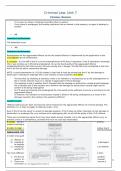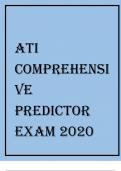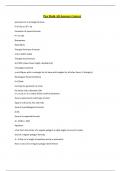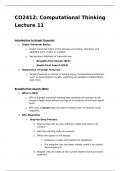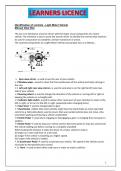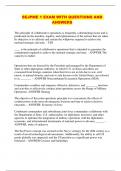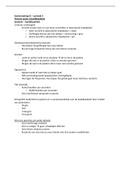1
Chapter 17- Inferential Statistics
Inferential statistics, which are based on laws of probability, allow
researchers to make inferences about a population based on data from a
sample; they offer a framework for deciding whether the sampling error that
results from sampling fluctuations is too high to provide reliable population
estimates. - answer-
The sampling distribution of the mean is a theoretical distribution of the
means of an infinite number of samples drawn from a population. The
sampling distribution of means follows a normal curve, so the probability that
a specified sample value will be obtained can be ascertained. - answer-
The standard error of the mean (SEM) -- the standard deviation of this
theoretical distribution-- indicates the degree of average error of a sample
mean; the smaller the SEM, the more accurate are the same estimates of the
population mean. - answer-
Statistical inference consists of two approaches estimating parameters and
testing hypotheses. Parameter estimation is used to estimate a population
parameter. - answer-
Point estimation provides a single descriptive value of the population
estimate (e.g. a mean or odds ration). Interval estimation provides the upper
and lower limits of a range of values-- the confidence interval (CI)-- between
which the population value is expected to fall, at a specified probability.
Researchers establish the degree of confidence that the population value lies
within this range. A 95% CI indicates a 95% probability that the true
population value lies between the upper and lower confidence limits. -
answer-
Hypothesis testing through statistical procedures enables researchers to
make objective decisions about the validity of their hypotheses. - answer-
The null hypothesis states that there is no relationship between research
variables, and that any observed relationship is due to chance. Rejection of
the null hypothesis lends support to the research hypothesis. - answer-
A Type I error occurs when a null hypothesis is incorrectly rejected (a false
positive). A Type II error occurs when a null hypothesis is wrongly accepted
(a false negative). - answer-
[Type here]
, 1
1
Researchers control the risk of a Type I error by establishing a level of
significance (or alpha level), which is the probability that such an error will
occur. The .05 level means that in only 5 out of 100 samples would the null
hypothesis be rejected when it should have been accepted. - answer-
In testing hypotheses, researchers compute a test statistic and then
determine whether the statistic falls at or beyond the critical region on the
relevant theoretical distribution. If the value of the test statistic indicates
that the null hypothesis is "improbable," the result is statistically significant
(i.e. obtained results are not likely to result from chance fluctuations at the
specified level of probability). - answer-
Most hypothesis testing involves two-tailed tests, in which both ends of the
sampling distribution are used to define the region of improbable values; a
one-tailed test may be appropriate if there is a strong rationale for an a priori
directional hypothesis. - answer-
Parametric tests involve the estimation of at least one parameter, the use of
interval- or ratio-level data, and assumptions of normally distributed
variables; nonparametric tests are used when the data are nominal or ordinal
or when a normal distribution cannot be assumed- especially when samples
are small. - answer-
Tests for independent groups compare separate groups of people, and tests
for dependent groups compare the same group of people over time or
conditions (within-subjects designs). - answer-
Two common statistical tests are the t-test and analysis of variance
(ANOVA), both of which are used to test the significance of the difference
between group means; ANOVA is used when there are three or more groups
(one-way ANOVA) or when there is more than one independent variable (e.g.
two-way ANOVA). Repeated measures ANOVA (RM_ANOVA) is used when
there are multiple means being compared over time. - answer-
Nonparametric analogs of t-tests and ANOVA include the Mann-Whitney U
Test and the Wilcoxon signed-rank test (two-group situation), and the
Kruskal-Wallis and Friedman tests (three-group or more situations). - answer-
The chi-square test is used to test hypotheses about differences in
proportions. For small samples or small cell sizes, Fisher's exact test should
be used. - answer-
Statistical tests to measure the magnitude of bivariate relationships and to
test whether the relationship is significantly different from zero include
[Type here]

